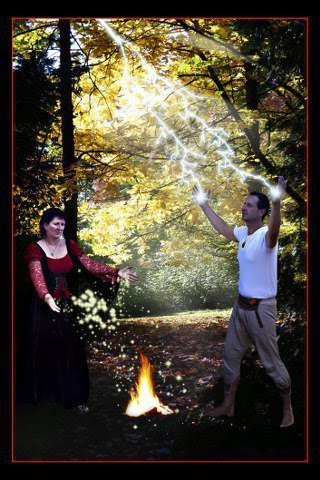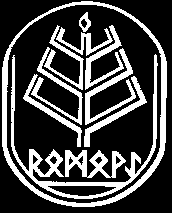The
following is a description of the Lithuanian Sventes included with the dates
that they are celebrated here in Australia. The conversion to the Australian
Romuvos calendar was fairly straight forward because the dates for the Sventes
are determined by seasonal, agricultural or astronomical observances which are
clearly opposite here in Australia. For example, when Lithuanians celebrate the
Summer Solstice in December, Australian Lithuanians are celebrating Winter
Solstice at the same time. When Lithuanians honour the dead in the dying season
of Autumn, Australian Lithuanians are celebrating the flourishing of nature in
Spring and when Lithuanians are escorting Winter with song and dance,
Australian Lithuanians are celebrating the harvest.
The fact
that climate and seasons greatly vary in Australia and by no means comparable
to the climate in Lithuania where they get down to -45 degrees Celsius in
Winter. In much of Australia, there are no real seasons as the Europeans know
it. In the Northern Territory, for example, Aboriginal people mark their year
by food availability and the cyclic weather events. The season of Emu egg
collecting is known when looking at the Milky Way, the shape of an Emu laying
down can be seen. Knock em down storm season wouldn’t be easy to ignore. There
are many more seasons recognised by the Indigenous Aboriginal people than
Europeans and the clear difference in calendars can be understood when you
realise that Aboriginal people were not agriculturalists. The European seasonal
calendar doesn’t apply in much of this country, however, where I live is fairly
temperate in weather and growing my veges brings me much joy so the seasonally
adjusted European and Lithuanian Pagan agricultural calendar does work for me,
in the place where I live, here in Australia.
From the
diagram it can be clearly seen that the Sventes of Lithuania are astronomically
and seasonally opposed so when celebrating them at the correct time of year
brings a certain harmony within yourself, your community and the Gods and
Goddesses of nature and the universe.
Lithuanian
Ethnic Religion Calendar Holidays
Holiday
Date in
Lithuania-LT
Date
in Australia-AU
Brief
Description
Prieskaledis
(Pre-Solstice preparations)
9-20/12-24 December LT
9-20/12-24
June AU
Preparation for the Winter solstice Eve
Preparation
for the Kucios meal
Kūčios
(Winter
Solstice Eve)
20/24
December LT
20-24 June
AU
Union
between the living and the dead. The last day of the Lithuanian year. Family
holiday. After reconciliation and forgiveness, everyone sits
together at the holiday table. Some of the 13 dishes,(representing
the 13 Lunar months), must be eaten by all if a prosperous year is to be had. Many
divinations and prognostications are performed.
Kaledos
(Winter
Solstice and New Year's Day)
21/25
December LT
21-25 June
AU
People pay homage to the Sun and blessings
for the new solar year.
Tarpukaledis
(Intra-Solstice)
21
December-2 January/25 December-6 January LT
21 June-6
July AU
Days of rest. Traditional
women's and men's work is forbidden
Pusiaužiemis
(Mid-winter)
25
January (in older practice: the first new moon, called the foal, after the
Winter Solstice) LT
25
July AU
Synonymous
with lunar new year. Krikstas and new year celebration. Badgers, porcupines,
and bears leave their caves or turn on their sides.
This determines how long Winter will last.
+Perkūno
diena
(Perkunas Day)
2 Feb LT
2 August
AU
Blessing
of candles(death candles), linen and ever green trees. Songs and prayers to
Perkunas,the mighty Thunderer for strength and courage.
We await the first sound of Springtime
thunder, wakes nature from Winters slumber.
+Gabijos
diena
(Goddess
Gabija day)
5
Feb LT
5 August
AU
People bless of bread and people. Songs
and prayers to Gabija, Thanks given to her for her Fire that cooks our food and
gave us light, warmth and comfort through the cold Winter months.
Goddess of the home hearth, Guardian of
Fire and grains.
+ These festivals combined are similar in some ways to the Celtic
festival called Inbolc.
Užgavėnės
(Mardi
Gras, Pancake Tuesday, Shrove)
Varies in
February LT
Varies in
August AU
Rite to usher out winter. A mock
battle between the Bacon God and the Hemp God takes place where the later
always wins. Burning of the More(Hag of Winter). Costumed people sing and dance
as they go visiting.
Vieversio
diena/Kazimerines
(Skylark
day, St Kazimeras)
24
February LT
25 August
AU
Craft markets and parades to
celebrate the official beginning of Spring remembering the traditional tale
from Lithuanian mythology that recalls when the Blacksmith God forged the Sun
and threw her into the sky.
Verba
(Flower
and herb lance)
Varies in
March LT
Varies in
September AU
Pavasario
lyge
(Spring
Equinox)
20-21
March LT
23
September AU
Welcomes
Spring. Blessing renewal of life.
Velykos
(Easter) aka velykiu velines
(Easter,
Easter for the Souls,The Great Day)
Varies in
April LT
Varies in Sept 2010 AU
Spring time
to honour given to the Ancestors. People exchange coloured and decorated eggs. Egg games
played. Swings made and people swung to help nature by bringing energy from the
sky to the Earth and vice versa by performing the swinging action. People
blessed certain foods to ensure that you have food all year. People whipped
with Verbos (green branch) and sprinkled with blessed water. The green branch
is believed to be magical and can bestow health and good fortune.
_____________________________________________
Jore; now
known as Jurgines
(St George
day)
23 April
LT
30 Sept AU
Celebrates
new growth of Spring. Animals are herded for the first time. The earth
cannot be moved on this day. Rituals of bread making performed. Bread was
buried in the fields and gardens. After placing a bread roll on the ground
a farmer would put one ear to the ground, farmers would listen to the Rye
to find out if it will be a good harvest. The God of the Spring Thunder
was called Jore or Joris. He evoked the forces of Life. Jore owned the key to
the Land, which when Earth is unlocked Jore sends rain and resurrects all
vegetation. Flowers and Herbs were offered to Zemyna Goddess Earth
Goddess, Pergubis God of all plants along with 15 other vegetation Gods
were honored.
Sekmines
Varies in
June LT
Varies in
December AU
End of
sowing and commence of Summer work. People revelled in the abundance of nature.
Houses and cattle adorned with flowers wreaths and Birch. Cattle incensed
(smudged) Certain Divinations and Charms made. People performed similar
blessings of grasses in churches, as at Zolines. Fire and Water was also
blessed. Wedding games played by
youth express Pagan beliefs that peoples sexual love and fertility
stimulate Earths productivity.
Pre Solstice Days. Preparation for
the Solstice.
9-20/12-24
June LT
9-20 December
Rasa
a.k. a. Kupoline
(Dew,
Herb Pole Day, Eve of Summer Solstice)
21-24 June
LT
21-21 December
AU
Homage to
the sun and medicinal herbs. Celebrated by many young people. Bon
fires are kept during the night and until the dear Sun reappears. Wreaths are
woven and set adrift, fortunes told, divinations performed, the fern
blossom is sought at midnight. The hay harvest begins after this holiday.
"Tarpukaledis"
(intra-solstice day).
Young people celebrate. The old year is burned. A
sub-set of the Kaledos traditions are celebrated. The skies and the
heavens predict the future weather and harvest.
*Rugiu
Svente
(Rye
holiday)
25 July LT
25
January, Australia Day AU
Blessing of rye and other grain crops at
the harvest.
*Prinokimo
Svente
(Ripe
holiday)
26 July LT
26
January AU
End of
the rye harvest. The first new bread is baked.
Berries are
ripe.
_________________
*These festivals are often combined.*
_________________
Žolinės
(Meadow
Grass celebration)
15 August
LT
15
February AU
Coming of
autumn. People gathered grass from their fields and gardens and brought it
to churches to be blessed. Rye, wheat and oat ears were tucked into these
grass bundles. In the spring, these ears were crushed and sprinkled on
the seeds to be planted. Other bundles of blessed grasses were used as
medicine, as protection from lightning strikes and to be sewn into coffin
pillows. Families always tried to gather together on this day to ensure
the coming year would be a productive one. The spring crop harvest begins
Dagotuves,
Rudens Lyge
(Autumnal
Equinox)
20-21
September LT
21 March
AU
Harvest
celebration
Ilges
a.k.a. Velines
(Lengthening,
Day of the Shades)
21
September-2 November LT
21
March-2 May(Main memorial on ANZAC Day) AU
Remembrance of
the Dead. Reconciliation is sought between the Living and Dead. Donations are
given to elgetos. Old and ill people, who cannot make enough to eat,
become elgetos.
Over many
years of research, I have learnt many of the traditional customs contained in
literary material collected by numerous academic and ethnographic researchers
of my Lithuanian ancestors. Trinkunas, Balys, Velius and Gimbutas just to name
a few. I visited Lithuania and participated in most of these Sventes first hand
to learn the practical side of these celebrations. I realised that it would be
impossible to replicate here in Australia, the national joy, enthusiasm,
customs, songs and dances that erupt everywhere in Lithuania, when celebrating
the Solstices and Equinoxes. I have formulated my own Australian Lithuanian
calendar as the relevant Sventes are expressed in my life, here Down Under.
There are actually many more Sventes, birthdays, funerals and namesgiving but I
am trying to keep this article brief.
Sources:
JonasTrinkunas,ed.Of Gods and Holidays.[ Vilnius ]:Tverme,1999.110-111.Jonas
Trinkunas.Baltu tikejimas: Lietuviu pasaulejauta,paprociai, apeigos, Zenklai.
Vilnius : Diemedzio leidykla, 2000. 45.Prane Dunduliene.Lietuvui Sventes:
Tradicijos, paprociai, apeigos. Vilnius: Mintis,1981.
Australian
references by Steven Kryžius



.jpg)
















